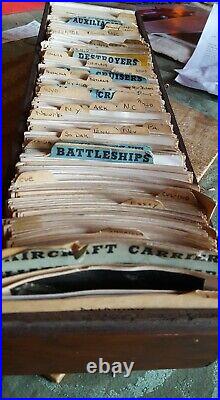
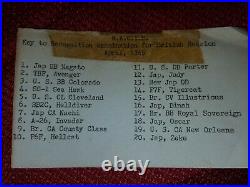
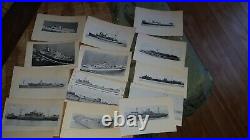
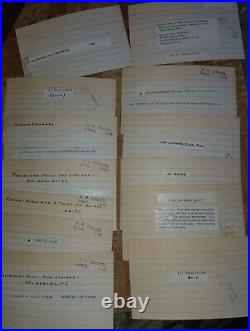


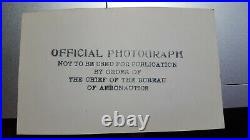
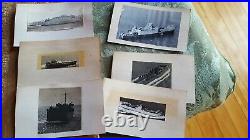

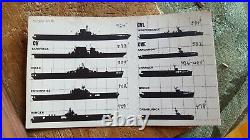
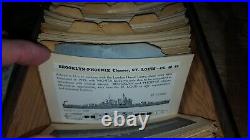


This lot came directly from the Rhode Island estate one of the instructors of the NACIS and his name is printed on many of these. These flash cards or recognition cards measure 3 x 5 inches each and the archive is arranged by type of craft and image count: 152 Aircraft Carriers, 164 Battleships, 73 Heavy Cruisers, 302 Light Cruisers & Destroyers, 56 Submarines, and 85 Tankers, Landing Crafts, etc, for a total of 832 images. Additionally, some of the craft types are broken down by name and type- the Aircraft Carriers, for instance, are broken down by name- The USS Ranger, USS Enterprise, USS Saratoga, USS Essex, etc. The flash cards, some marked “Confidential”, contain mostly aerial photos and printed paper images of the actual craft in question. The USS Enterprise, for instance, has about 25 images and printed drawings, schematics, etc, dedicated to it, from as many different angles as was available at the time. As stated, all of these images were classified, many (mostly photographs printed on photographic paper) are stamped on the back”Official Photograph- Not to be used for publication by order of the chief of the Bureau of Aeronautics. The NACIS trained many personnel during World War 2, and this is as complete an archive of that training school as you could wish for given it came from one of the instructors there and is still to this day a pretty much unknown entity. Again, there is here a total of 830 flash cards, split out between actual photographic images and military issued classified pre printed images of the major military craft of World War 2. The backs of each image bear the technical info on the ships and the date the image was taken. Here’s some info on the NACIS from a book called “The Navy’s Air War” published by Harper & Brothers, New York & London, 1946. Another important aspect of training, and one that was continued throughout the pilot’s career even in the combat area, was recognition training. The best training in the world was of little use if the pilot used this skill to knock down our own planes, bomb our own submarines, or attack our own vessels. It was equally of little avail to train men to the peak of perfection in combat technique, if they sat back to watch casually the approach of a friendly plane, only to find out too late that they were welcoming a Jap Zero or Betty. To combat these possibilities, recognition courses of limited scope had been given as early as the First World War. A smattering of such training had been given in American models prior to the Second World War. The first wartime innovation was the launching of the Aircraft Model Program, in which the Navy in January, 1942, asked the youth of the nation to build 500,000 models of standard combat aircraft. Plans and standard templates were furnished through the Office of Education, which cosponsored the project, to the school systems of the nation. Soon small-scale models, carefully drawn to such a scale that at 35 feet the model would appear as a plane would at half a mile, were flying from the ceilings of recognition classrooms, pilot ready rooms, and barracks reading rooms. So hearty was the initial response of high school boys and girls all over the nation, that an additional 300,000 models were requested before the year was out. Certificates were given students after they had completed a certain number of models. The Navy and the nation owe a debt of gratitude to this unselfish service of its youth. The early stages of recognition training were based on the socalled WEFT (Wings, Engine, Fuselage, Tail) system. It was found, however, that in actual combat there was barely time to count to four, much less attempt to analyze four different characteristics of a rapidly approaching plane. Since recognition so often had to be practically instantaneous, a new type of visual recognition was perfected by Dr. Samuel Renshaw, of the Ohio State Research Foundation. A crude analogy of this theory was often given by recognition instructors. They pointed out that one could recognize a friend walking down the street, without knowing, or at least without having to call to mind, before recognition, the color of his eyes, the shape of his head, or his waist measure. The Ohio State system was adopted by the Navy in May, 1942, and a special school was opened at Ohio State University, 20 July 1942, to train twenty-five recognition instructors every two weeks, a course which was quickly extended to two months. The system featured the use of slides, flashed on a screen at rates varying from an initial 110 of a second working up for a while to 175 of a second. This put a premium on the flash or instantaneous recognition of friendly and enemy types so essential under combat conditions. The Ohio State system became universally adopted and was taught in the fleet, in shore stations, and in practically all training schools other than the technical training maintenance schools. An important aspect of flight training from the diplomatic standpoint was the training of foreign pilots. Under lend-lease agreements, training of Latin-American pilots and a few Free French pilots was begun in 1942. Occasional representatives of Latin-American countries had been trained in the past, but the program had not been on a firm basis. In April, 1942, however, invitations were issued to most of the Latin-American countries through the State Department, and favorable responses were received immediately from seven countries and later from others. The first men arrived from Peru in May, 1942, and a small but steady stream followed from Argentina, Brazil, Chile, and other countries to the south. The largest number trained were from Brazil. In all more than three hundred p316 received this training. The training program for these individuals was modified and in general, for purposes of security, excluded operational training. Toward the close of the year training was inaugurated for the Free French, and since these men were at war, they received more thorough training. In 1944, when Catalinas were transferred to the Soviet government, Russian flight crews were sent to this country and given training to acquaint them with this type of plane and its equipment. STRIPES ON A BUSINESS MAN. The training of ground officers, newly commissioned from civilian life, tentatively begun in the field of aeronautical engineer officers in February, 1941, swelled immediately after Pearl Harbor. Following British precedent, a school for training officers in photographic interpretation was convened at Anacostia, District of Columbia, 5 January 1942. An outstanding school for developing ground officers was that conducted at Quonset Point, Rhode Island. The original plans to have all Reserve officers for the aeronautical organization trained at Anacostia, under discussion in December, 1941, were quickly dropped, and in February, 1942, the Naval Training School (Indoctrination) was established at the huge and relatively new air station at Quonset Point, Rhode Island. The underlying theory of this school was that men who were successful lawyers, businessmen, teachers, and newspapermen could with a modicum of indoctrination become very useful in different administrative capacities to naval aviation, and could relieve pilots for combat or instructional purposes. As a result, men from all walks of life, from their late twenties to late forties were commissioned and poured into Quonset. Here they were subjected to a two months’ period of military drill, courses in the fundamentals of naval service, recognition, naval aviation, naval regulations, naval courts and boards, and seamanship. Those who lived through this period will always have certain ineradicable memories: the Iowa merchant, who a few weeks before had been bossing clerks around in a dry-goods store, painfully trying to unravel the intricacies of an official naval letter; the North Carolina realtor having trouble differentiating between an F4U and a navy blimp flashed on the screen at 125 of a second; the Maine hotel man vainly trying to recall which was his right shoulder on the drill grounds; the California professor shining the shoes of an Ohio newspaperman preparatory to inspection; the New York stockbroker fussing over a wrinkle in his bunk sheet with all the meticulousness of an elderly spinster. P317 Upon the completion of the course, which handled as many as 750 officers at one time, the graduates were parceled out among the various establishments of naval aviation. They went to sea frontiers, air stations, further training for specialized tasks, to become photographic officers, fighter directors, and engineering officers to mention only a few of the many tasks performed by this group. An important outlet for the younger Quonset men especially was the Air Combat Information School, which was also established at Quonset. These were the men who briefed the pilots before and after flight, kept them abreast of operational data, and collected intelligence information both for the pilots and for higher echelons. Hardly a history of a naval squadron has been written without tribute being paid the willing and effective contribution of these men. Much of their entrenchment cannot be measured by any tangible gauges, but by the intangible factor of personal relationship. The ACI officer, though often some years older than the pilots, ate with them, and when occasions permitted, drank with them, worked with them, counseled them, and all in all acted as a leveling influence on young men living under the terrible uncertainty of modern war. The item “1942-45 US Naval Air Combat Information School Training Photo Archive 830 Images” is in sale since Wednesday, January 20, 2021. This item is in the category “Collectibles\Militaria\WW II (1939-45)\Original Period Items\United States\Photographs”. The seller is “amsons” and is located in Portland, Maine. This item can be shipped to United States, Canada, United Kingdom, Denmark, Romania, Slovakia, Bulgaria, Czech republic, Finland, Hungary, Latvia, Lithuania, Malta, Estonia, Australia, Greece, Portugal, Cyprus, Slovenia, Japan, China, Sweden, South Korea, Indonesia, Taiwan, South africa, Thailand, Belgium, France, Hong Kong, Ireland, Netherlands, Poland, Spain, Italy, Germany, Austria, Bahamas, Israel, Mexico, New Zealand, Philippines, Singapore, Switzerland, Norway, Saudi arabia, United arab emirates, Qatar, Kuwait, Bahrain, Croatia, Malaysia, Chile, Colombia, Costa rica, Panama, Trinidad and tobago, Guatemala, Honduras, Jamaica, Antigua and barbuda, Aruba, Belize, Dominica, Grenada, Saint kitts and nevis, Saint lucia, Montserrat, Turks and caicos islands, Barbados, Bangladesh, Bermuda, Brunei darussalam, Bolivia, Egypt, French guiana, Guernsey, Gibraltar, Guadeloupe, Iceland, Jersey, Jordan, Cambodia, Cayman islands, Liechtenstein, Sri lanka, Luxembourg, Monaco, Macao, Martinique, Maldives, Nicaragua, Oman, Pakistan, Paraguay, Reunion, Uruguay.

